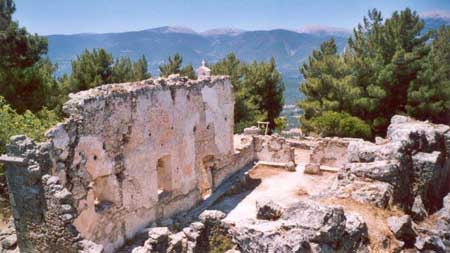Greece. Kephallénia
MIDDLES AGES TO RECENT TIMES
Late Antiquity, with an important Christian basilica from around 500 AD at coastal Panormos / later Phiscardo, not far from Nicopolis (at present-day Preveza), represented a new growth in settlement.
Byzantine Kephallénia is relatively poorly known, but Kephallénia did give name to a military district (thema). In the Norman/Italian phase (c1200 till c1500 AD), or even slightly earlier, the acropoleis of the ancient cities were re-fortified to serve as strongholds, and several monasteries were built. Further building, including fortresses, manors and fine churches, took place in the Venetian period (till c1800 AD). (Kephallenia-Ithaka were never part of the Ottoman Empire .)

The Medieval church of Ag. Nikolaos on the slope of the Kyatis hill, N of Samme acropolis.
The British (till 1864) in particular developed the towns of Western Kephallénia , and built roads and bridges. The population of Kephallénia peaked in the early twentieth century AD.
In 1953 a major earthquake destroyed almost all of Kephallénia. With communication being more important already then than an optimal location vis-à-vis the agricultural and highland resources, the new, and less populous, settlement moved down to the main roads. This left a Greece before modernity in the form of dozens and dozens of ghost-villages, an ethnological present (with informants still around) turning slowly into the archaeological data of the future. |